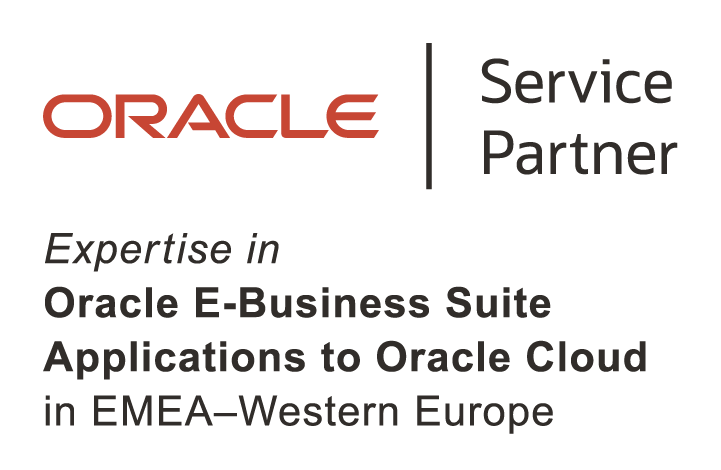
Oracle Enterprise Command Centers
Content
An ECC is an information layer which sits above your transactional Oracle E-Business Suite data. An ECC is deployed as a dashboard containing various methods of displaying your data. Essentially, the purpose of an ECC is threefold:
- Help you answer questions about why my UK ledgers take so long to close.
- Help the decision-making process by providing varied views of your data and the performance of your organisation
- Help you to spot patterns via rich visual data displays



ECCs are a significant benefit of EBS R12.2. Out-of-the-box ECCs allow customers to identify and respond to key business transactions without needing a custom reporting solution. They provide dashboard-style reporting and intelligence and the ability to drill into specific areas to see a more detailed view of transactional data.
Available since 2018, ECCs can be installed on any EBS instance at version 12.2.4 or above. There is no separate license or additional cost for installing and running the ECCs. However, there may be additional infrastructure requirements to run the ECC dashboards. To ensure a successful deployment of the ECC, it is recommended to use either additional virtual or separate physical architecture.
These dashboards allow users to access interactive visual components to effortlessly locate and retrieve any transactions requiring attention. With this simplified process, there is no need to use custom or standard operational reports, scripts, or conventional search screens. Transaction screens are pre-populated with the drill-down data from your information discovery with no re-querying of data necessary.
Dashboards can be used by various users, from departmental managers to operational resources. They are fully configurable and can be tailored to meet your organisation’s and personnel’s specific needs.
The latest release of the ECC Framework offers 36 command centres and 145 dashboards.
- Browse and drill on actionable indicators
- Use consumer-like search and filters
- Drill down with all indicators and search choices recalculated
- Through “conversation with the data”, narrow in on the most important priorities
- Navigate to selected transactions to take action
The power of the ECC dashboards is down to the ECC Framework, which it sits on top of. This middleware technology is a powerful and scalable piece of architecture and consists of three layers:
- Interactive User Interface layer: This development framework allows code-free creation of dashboards using a drag-and-drop layout design.
- Service Layer: This allows the client to define a dataset and perform advanced functions, such as aggregation and rollups, against the data.
- Core Engine: The main engine absorbs data from its source EBS module and analyses it to allow fast and advanced data access.
The ECC framework enables Oracle EBS users to modify the dashboards’ design easily. It provides the capability to access additional data from within E-Business Suite, including advanced data retrieval functionality such as aggregations, rollups, etc.
The following list is not exhaustive but illustrates the breadth of content available.
- Oracle Financials: Receivables, IReceivables, Payables, Assets, Lease Contracts (Financials), Lease, Finance Management and General Ledger (new in ECC v9)
- Oracle Manufacturing: Discrete Manufacturing, Process Manufacturing, Outsourced Manufacturing, Project Manufacturing, Cost Management, Quality
- Oracle Procurement: Iprocurement, Consumer-like shopping, Procurement, Projects, Project Procurement, Contract Lifecycle Management for Public Sector
- Order Management & Logistics - Order Management: Inventory Management, Advanced Pricing, istore, Modern Shopping Experience, Landed Cost Management, Channel Revenue Management, Incentive Compensation
- Asset Lifecycle and Service: Enterprise Asset Management, Asset Tracking, ServiceContracts, Service (TeleService), Field Service, Depot Repair
- Oracle Human Capital Management: Human Resources and Payroll
ECC Framework requires a new Web Logic server installation. It is recommended that it run on a separate server from E-Business Suite Applications. To install, patch, and configure the ECC, you must utilise DBA support to install a patch and establish a data refresh.
Several initial customisations and settings need to be applied at the point of installation, and they can be completed in-house with DBA support. However, DSP provides a cost-effective service to ensure that installation goes smoothly and without incident.
It takes approximately three days to install, patch, and complete the data configuration.
The memory required by an ECC is shown in the following image, but it is dependent on the dashboard you are using. These are the minimum specifications from Oracle.
DSP's experience with ECCs has taught us that these recommendations are the bare minimum, and increasing them is required in some cases.

ECCs cover a wide range of data in your EBS database and have various visualisation tools and drill-down reporting features. They can support your analysis and decision-making by honing in on problem areas.
Careful thought needs to go into areas such as server architecture and data refresh frequency to create the optimum balance between performance and usefulness.
- Initial architectural analysis on the best way to run an ECC on a separate server.
- Functional areas available that benefit the organisation and how to implement them.
- Setting up the initial data gathering and periodic data refreshes required to operate an ECC.

Contact us Today
Fill out the form below and we'll be in touch shortly!


.png?width=250&height=56&name=stonewater-logo%20(1).png)
